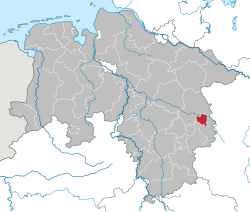
Back Wolfsburg Afrikaans Wolfsburg ALS Wolfsburg AN Wolfsburg ANG فولفسبورغ Arabic Wolfsburgu AST Volfsburq Azerbaijani وولفسبورق AZB Вольфсбург Bashkir Wolfsburg BAN
This article needs additional citations for verification. (April 2011) |
Wolfsburg
Wulfsborg (Eastphalian) | |
|---|---|
 Skyline of Wolfsburg at dusk | |
| Coordinates: 52°25′23″N 10°47′14″E / 52.42306°N 10.78722°E | |
| Country | Germany |
| State | Lower Saxony |
| District | Urban district |
| Subdivisions | 16 Ortschaften, 40 Stadtteile |
| Government | |
| • Lord mayor (2021–26) | Dennis Weilmann[1] (CDU) |
| Area | |
• Total | 204.02 km2 (78.77 sq mi) |
| Elevation | 63 m (207 ft) |
| Population (2022-12-31)[2] | |
• Total | 125,961 |
| • Density | 620/km2 (1,600/sq mi) |
| Time zone | UTC+01:00 (CET) |
| • Summer (DST) | UTC+02:00 (CEST) |
| Postal codes | 38400–38448 |
| Dialling codes | 05361, 05362, 05363, 05365, 05366, 05367, 05308 |
| Vehicle registration | WOB |
| Website | www.Wolfsburg.de |
Wolfsburg (German: [ˈvɔlfsbʊʁk] ⓘ; Eastphalian: Wulfsborg) is the fifth-largest city in the German state of Lower Saxony, located on the river Aller. It lies about 75 kilometres (47 mi) east of Hanover and 230 kilometres (143 mi) west of Berlin.
Wolfsburg is famous as the location of Volkswagen AG's headquarters and, until it was overtaken by Tesla Gigafactory Texas in 2022, the world's biggest car plant. The Autostadt is a visitor attraction next to the Volkswagen factory that features the company's model range: Audi, Bentley, Bugatti, Ducati, Lamborghini, MAN, Neoplan, Porsche, Scania, SEAT, Škoda Auto and Volkswagen Commercial Vehicles. Wolfsburg is one of the few German cities built during the first half of the 20th century as a planned city. From its founding on 1 July 1938 as a home for workers producing the KdF-Wagen until 25 May 1945, the city was called Stadt des KdF-Wagens bei Fallersleben. In 1972, the population first exceeded 100,000. In 2019, the GRP was €188,453 per capita.[3]
- ^ "Stichwahlen zu Direktwahlen in Niedersachsen vom 26. September 2021" (PDF). Landesamt für Statistik Niedersachsen. 13 October 2021.
- ^ "LSN-Online Regionaldatenbank, Tabelle A100001G: Fortschreibung des Bevölkerungsstandes, Stand 31. Dezember 2022" (in German). Landesamt für Statistik Niedersachsen.
- ^ "Kreise mit höchstem Bruttoinlandsprodukt je Einwohner". Statista (in German). Retrieved 22 August 2022.




